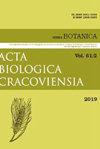The Influence of Methyl Jasmonate and Salicylic Acid on Secondary Metabolite Production in Rehmannia Glutinosa Libosch. Hairy Root Culture
IF 0.5
4区 生物学
Q4 PLANT SCIENCES
引用次数: 28
Abstract
Rehmannia glutinosa hairy roots were used to evaluate the effect of methyl jasmonate (MeJa) and salicylic acid (SA) on increase of root biomass and production of iridoids (catalpol, harpagide) and phenylethanoids (verbascoside and isoverbascoside). The elicitors were added to 23-day-old culture separately at concentrations between 50 and 200 μM or in combinations at concentrations of 50 and 100 μM. Roots were harvested 72 h and 120 h after elicitation. The type of elicitor, its concentration and exposure time were found to strongly affect the content of each analyzed compound. A 72-hour treatment with 200 μM MeJa was the most effective in increase of verbascoside content (60.07 mg·DW-1 equivalent to 845.45 mg·L-1) and isoverbascoside (1.77 mg·DW-1 equivalent to 24.94 mg·L-1): these respective amounts were roughly 10and 6.4-fold higher than the control values (unelicited roots). Exposure to 150 μM MeJa provided optimal harpagide content after 72 hours (0.136 mg·DW-1; 7.5-fold increase compared to the control), and catalpol content after 120 hours (up to 2.145 mg·DW-1). The combination of MeJa and SA also resulted in higher levels of secondary metabolites compared to the control culture, although these levels were lower than those observed for MeJa alone at the optimal concentration and exposure time. SA alone was less efficient in enhancing metabolite production than MeJa.茉莉酸甲酯和水杨酸对地黄次生代谢物产生的影响。毛状根培养
以地黄毛状根为试验材料,研究了茉莉酸甲酯(MeJa)和水杨酸(SA)对地黄毛状根生物量和环烯醚萜类化合物(梓醇、哈巴苷)和苯乙醇类化合物(毛蕊花糖苷和异毛蕊花糖苷)产量的影响。将激发子分别以50 ~ 200 μM的浓度或以50 ~ 100 μM的浓度组合添加到23日龄的培养液中。在诱导72 h和120 h后分别收获根。激发剂的种类、浓度和暴露时间对所分析化合物的含量有很大影响。200 μM MeJa处理72小时对毛蕊花苷含量(60.07 mg·w -1,相当于845.45 mg·L-1)和异花花苷含量(1.77 mg·w -1,相当于24.94 mg·L-1)的增加最为有效,其含量分别比对照组(未诱导根)高约10倍和6.4倍。暴露于150 μM MeJa中72小时后,harpagide含量达到最佳(0.136 mg·DW-1;120 h后梓醇含量达到2.145 mg·DW-1。与对照培养相比,MeJa和SA的组合也产生了更高的次级代谢物水平,尽管这些水平低于在最佳浓度和暴露时间下单独使用MeJa的水平。单独使用SA提高代谢物产量的效率低于MeJa。
本文章由计算机程序翻译,如有差异,请以英文原文为准。
求助全文
约1分钟内获得全文
求助全文
来源期刊
CiteScore
3.00
自引率
0.00%
发文量
0
审稿时长
>12 weeks
期刊介绍:
ACTA BIOLOGICA CRACOVIENSIA Series Botanica is an English-language journal founded in 1958, devoted to plant anatomy and morphology, cytology, genetics, embryology, tissue culture, physiology, biochemistry, biosystematics, molecular phylogenetics and phylogeography, as well as phytochemistry. It is published twice a year.

 求助内容:
求助内容: 应助结果提醒方式:
应助结果提醒方式:


